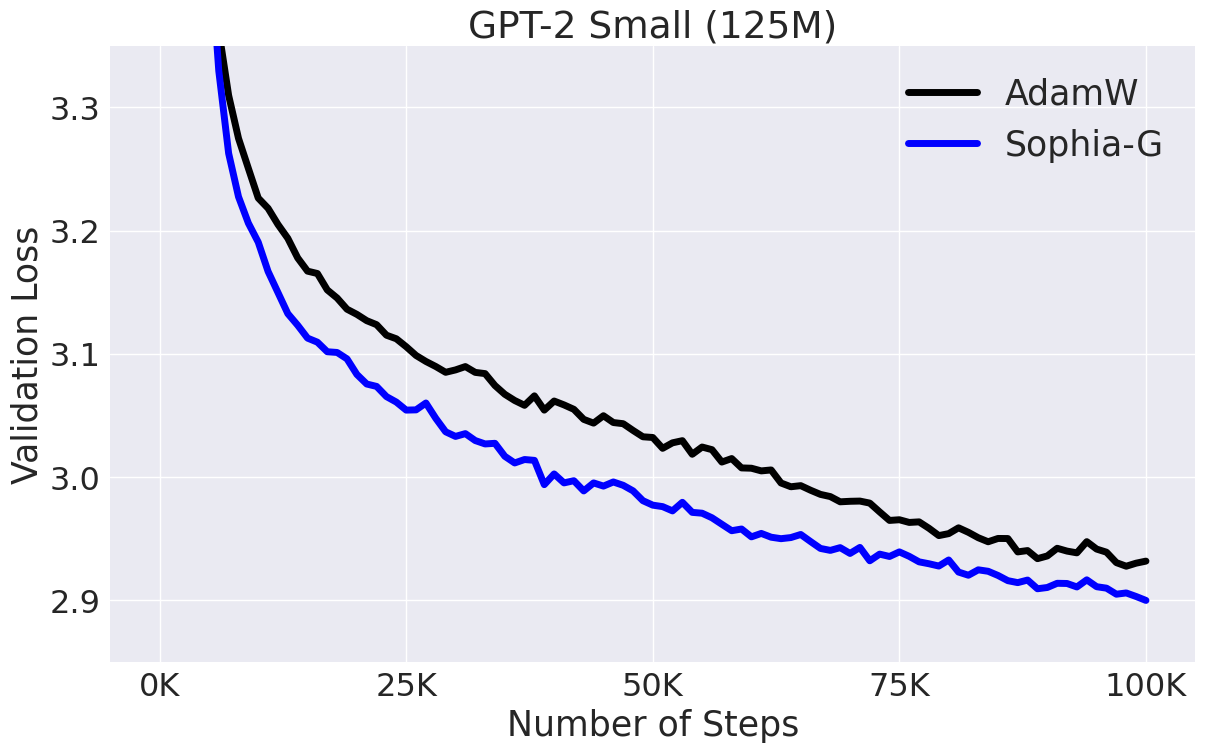This is an official implementation of the Sophia-G optimizer in the paper here and GPT-2 training scripts. The code is based on nanoGPT. Please cite the paper and star this repo if you find Sophia useful. Thanks!
@article{liu2023sophia,
title={Sophia: A Scalable Stochastic Second-order Optimizer for Language Model Pre-training},
author={Liu, Hong and Li, Zhiyuan and Hall, David and Liang, Percy and Ma, Tengyu},
journal={arXiv preprint arXiv:2305.14342},
year={2023}
}-
🔥 Watch Sophia running in the wandb report.
-
We will spend more resources on scaling up to larger models. Please feel free to let us know if you have any feedback or interesting findings from using Sophia.
-
For GPT-2 Middle (355M) and Large (770M), please see the hyperparameters we used to produce the results in the paper below in the hyperparameter tuning. The scripts will be released soon (potentially with an improved choice of hyperparameters that we are currently experimenting with.)
-
The JAX version of Sophia-H will be included at levanter, which is also an amazing code base for language model pre-training.
- pytorch 2.0
- transformers
- datasets
- tiktoken
- wandb
Prepare the OpenWebText data following nanoGPT:
$ python data/openwebtext/prepare.py
Start pre-training GPT2 Small (125M):
If you have a machine with 10 A5000 (24GB) GPUs,
$ torchrun --standalone --nproc_per_node=10 train_sophiag.py config/train_gpt2_small_sophiag.py --batch_size=8 --gradient_accumulation_steps=6
If you have a machine with 8 A100 (40GB) GPUs,
$ torchrun --standalone --nproc_per_node=8 train_sophiag.py config/train_gpt2_small_sophiag.py --batch_size=12 --gradient_accumulation_steps=5
To reproduce the AdamW baseline following nanoGPT:
$ torchrun --standalone --nproc_per_node=10 train_adam.py config/train_gpt2_small_adam.py --batch_size=8 --gradient_accumulation_steps=6
Please adjust nproc_per_node, batch_size, and gradient_accumulation_steps accordingly if you use other hardware setup. Make sure their product equals 480.
This will lead to results in the figure below:

import torch
from torch import nn
from sophia import SophiaG
#init model loss function and input data
model = Model()
data_loader = ...
#init the optimizer
optimizer = SophiaG(model.parameters(), lr=2e-4, betas=(0.965, 0.99), rho = 0.01, weight_decay=1e-1)
k = 10
iter_num = 0
#training loop
for epoch in range(epochs):
for X,Y in data_loader:
if iter_num % k != k - 1:
# standard training code
logits, loss = model(X, Y)
loss.backward()
optimizer.step(bs=4096)
optimizer.zero_grad(set_to_none=True)
iter_num += 1
else:
# standard training code
logits, loss = model(X, Y)
loss.backward()
optimizer.step(bs=4096)
optimizer.zero_grad(set_to_none=True)
iter_num += 1
# update hessian EMA
logits = model(X, None)
samp_dist = torch.distributions.Categorical(logits=logits)
y_sample = samp_dist.sample()
loss_sampled = cross_entropy(logits, y_sample)
loss_sampled.backward()
optimizer.update_hessian()
optimizer.zero_grad(set_to_none=True)
Definition of learning rate
- The update in the code is written as
$\theta_{t+1} = \theta_t - lr*\textup{clip}(m_t / (\rho * h_t + \epsilon), 1)$ , which is equivalent to the update in the paper up to a re-parameterization. (the$lr$ here corresponds to$\rho \cdot \eta_t$ in the paper).
Some tips for tuning hyperparameters (based on our limited tuning):
- Choose lr to be about half the learning rate that you would use for AdamW. Some partial ongoing results indicate that lr can be made even larger, possibly leading to a faster convergence.
- Consider choosing
$\rho$ in$[0.01, 0.1]$ .$\rho$ seems transferable across different model sizes. We choose rho = 0.03 in 125M and 335M Sophia-G The (lr, rho) for 335M, Sophia-G is chosen to be (2e-4,0.03). Though we suspect that lr can be larger. - Please feel free to let us know what you find out during hyper-parameters tuning. We appreciate your valuable feedback and comments!
The GPT-2 training code is based on nanoGPT, which is elegant and super efficient.